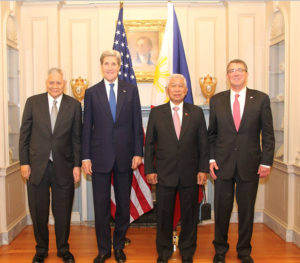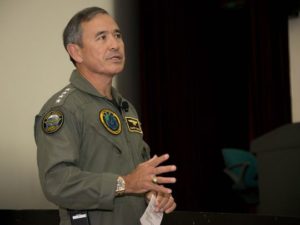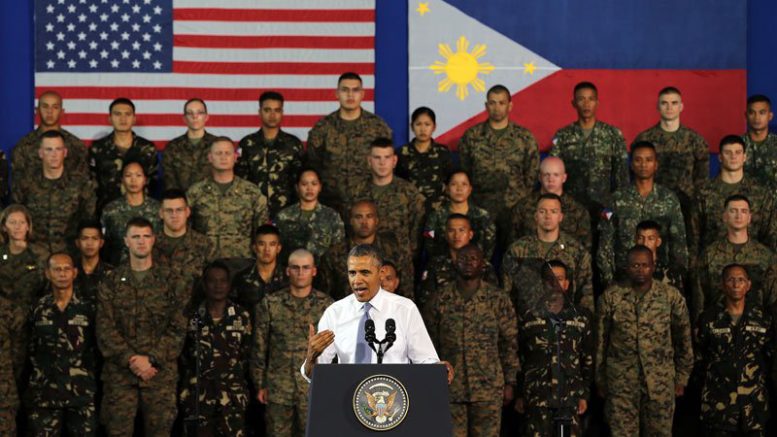The Philippines can be subverted, harassed and damaged technologically and economically.
China, with its geographical position, language, history, and civilization, has been a 5000 year-old political entity whose place in the world has already been fixed, according to Henry Kissinger, in his 600-page book titled “On China.” As U.S. Secretary of State, he paved the way for the visit of President Nixon to China in 1972 to meet with China Premier Chou En Lai, and restore full diplomatic relations between the two countries –close allies who fought the Japanese in WWII until 1945.
Relations between the two allies had soured from the late 1950’s after China became a communist state under Mao Tse Tung who as its revolutionary leader forced the U.S.-backed China President Chiang Kai Shek and his remaining Nationalist military forces to flee to the tiny island of Formosa, now Taiwan. This was further exacerbated by China’s alignment ideologically and militarily with then USSR (Soviet Russia), and support to North Korea with a 100,0000 army in the Korean War (1950-1953) where America suffered 40,000 casualties.
After centuries of isolation, humiliated by western powers, Great Britain, France and Germany at the close of the 19th century, and by Japan in half of the 20th century, which carved vast areas of its territory — China, exercising partial to full sovereignty, is now a world power in economy and trade, and seeks its place under the sun. A very significant aspiration of China as written by Jonatahn Holstag in his book “The Coming War with Asia” is its determination to recover Taiwan, establish hegemony over Hong Kong, have dominance in the seas bordering China, and take over the reefs and islands considered as territories of Japan, the Philippines, Vietnam, Malaysia, and Indonesia.
But according to former President Fidel V. Ramos in his paper “Strategic Leadership and the Challenges of Our Times,” he states, “Viewed from Beijing, the arc of military and political alliances which extends from the Korea Peninsula, Japan, Taiwan, Okinawa, Indonesia, Singapore, Australia and New Zealand, poses a strong deterrent and obstacle to military excursions and adventurism by China into the Pacific Ocean and South China Sea, renamed West Philippine Sea by the Philippine government.” (The Cavalier, Jan-Feb 2013)
These alliances and geopolitical realities in the West Philippine Sea and the Pacific have impelled China to invoke the so-called 9-dash Line (of dubious historical basis) and establish a chain of island bases as its far sea defense deterrence denial strategy to protect the mainland and further avail of the rich resources therein.
The U.S. has defense pacts with Japan, South Korea, Philippines, Australia and New Zealand (ANZUS), and a special security arrangement with the Taiwan.
The Philippines and United States Mutual Defense Pact signed on 24 August 195l provides that “Each Party recognizes that an armed attack in the Pacific area on either of the Parties would be dangerous to each own peace and security and would act to meet the common danger in accordance with its constitutional processes.”
This treaty was entered into one year after the Korean War broke out on 24 June 1953 when North Korea invaded South Korea. The war ended in an armistice in 1950, each side occupying the same territory as when the inconclusive war started. The Philippines, responding to the United Nations and under its auspices, sent to South Korea four army battalions of some 7,000 personnel fully equipped and supplied by the U.S., and fought side by side with American soldiers.
It is significant to note that in previous interpretations of the defense treaty, the areas covered Metropolitan Manila and the areas of U.S. Clark Air Base in Pampanga and Subic Naval Base in Zambales (vacated by U.S. in 1992) and the vast expanse of the Pacific Ocean on the eastern side of the Philippines toward the Hawaii islands.
Are the disputed islands located west of the Philippines covered by the treaty?
The disputed islands are in the Spratly group, 150 nautical miles west of Palawan, and some 550 miles from the coast of Hainan, the southern province of China, and the Scarborough Shoal, which is about 120 miles west of Zambales. These islands that have been traditional fishing grounds by Filipino seafarers and rich with marine resources, ocean minerals gas and oil reserves are within the 200-mile Exclusive Economic Zone of the Philippines.
The government of the United States has assured its commitments time and again to honor its defense treaty with the Philippines.
President Barrack Obama, during a state visit to the Philippines on April 2014 said before U.S. military personnel and Filipino soldiers assembled in Leyte, a province badly hit by typhoon Yolanda, “Our commitment to defend the Philippines is iron clad, and we keep that commitment because allies do not stand alone.”

Philippine DFA Chief Albert del Rosario; U.S. VP John Kerry; Philippine Defense Sec Voltaire Gazmin; and U.S. Defense Sec. Ashton Carton. Photo Credit: Philippine Embassy, Washington DC.
Philippine DFA Chief Albert del Rosario; U.S. VP John Kerry; Philippine Defense Sec Voltaire Gazmin; and U.S. Defense Sec. Ashton Carton. Photo Credit: Philippine Embassy, Washington DC.
U.S. Defense Sec. Ashton Carton repeated the assurance during a meeting in Hawaii in May this year with his counterpart Philippine Defense Sec. Voltaire Gazmin to whom he told that U.S. commitment is ironclad. He even called for China to halt its reclamation activities.
Admiral Harry Harris Jr., head of U.S. Pacific Command, is pushing an aggressive plan to contest China’s expanding island-building in the South China Sea. Photo credit: MC2 Kegan E. Kay, US Navy.
In a most public criticism of China’s land reclamation activities in South China, Admiral Harry Harris Jr., Commander of the U.S. Pacific Command based in Hawaii, accused Beijing of “building a Great Wall of sand over islands claimed by several countries. China’s pattern of provocations toward smaller claimant countries on the basis of the sweeping 9-dash Line which is inconsistent with international law, and the wide asymmetry between China’s capabilities and of her weak neighbors, raises serious questions about Chinese intentions.” These remarks were made during a naval conference of allied countries in Canberra, Australia in March this year. (Wall Street Journal, 1 April 2015)
He further reported that the runway being built in Mischief Reef west of Palawan is 10,000 feet long and could accommodate a U.S B-52 long range bomber and much longer than what is required for a Boeing 747 aircraft. Its harbors and ports under construction are deep enough for large naval vessels. These facilities would serve as staging bases that could threaten neighboring claimant countries.
In a briefing last May before the Senate Defense Committee, NICA Director General Cesar Garcia reported that the dispute over the islands in the South China Sea has overtaken all security concerns, and it is imperative that the AFP should now transition from its domestic security focus toward external or territorial defense.

Admiral Harry Harris Jr., head of US Pacific Copmmand, is pushing an aggressive plan to contest China’s expanding island-building in the South China Sea. Photo credit: MC2 Kegan E. Kay, US Navy.
“America still rules South China and the Pacific Ocean, and its 7th Fleet in case of war can choke maritime traffic to and from China,” writes Andrew Browne in the China World Wall Street Journal on 4 March 2015. Admiral Henry Harris Jr., Commander of the U.S. Pacific Command, declared that he would not allow any coercion, and would ensure that maritime lanes are open for international shipping valued at $5 trillion a year.
Will there be military confrontation between the United States and China over the disputed islands? The writer does not believe so in the immediate term. China, not being militarily at par with the United States will endeavor to avoid a situation where the Philippines or the United States would invoke the Philippines-United States Mutual Defense Pact. It has continually occupied, administered and possessed the disputed island’s essential elements in claiming rightful ownership.
According to Henry Kissinger, adviser of U.S. Presidents and world heads of state, China “follows an ancient board game called Wei Qi that stresses encirclement rather than domination. Chinese leaders value strategic envelopment rather than destructive confrontation,“ a strategy that closely adheres to Sun Tzu treatise on war. His famous dictum reads “the best commander is one who wins battles without fighting.”
True to its Anti Access/Area Denial (A2AD) doctrine, China employs a “cabbage strategy,” surrounding the disputed islands with ships that by sheer number, size and speed, thus Filipino fishermen and coast guard vessels are effectively denied entry without firing a shot.
Military analysts say China does not have sealift capability to transport a large number of troops, with weapons and vehicles, and undertake an effective invasion by sea. However, China recently held an exercise employing 20,000 troops in a coast facing Taiwan for a possible sea invasion. Because of the lack of bottoms, commercial ships are being configured to transport military personnel and cargo.
It will take weeks and even months to assemble a large number of troops, vehicles and landing craft, and mount an invasion by sea. It may take three to five days for a seaborne force from China closest coast to reach Philippine shores. Satellites orbiting 24 hours can take pictures, and CNN will send an alarm worldwide.
China can subvert, harass, and inflict damage to the Philippines technically and economically. Its cyber warfare capabilities can hack and cripple the computers that operate and control banking systems and devices, communication networks, power, aerodrome, and other vital facilities.
Possible targets of subversion are the local Filipino Chinese who comprise a mere 1% of the population but a big and influential factor in the economy who, by hard work, perseverance and risking their capital, are dominant or are highly prominent in retail, trading, airline, shipping, real estate development, banking and many manufacturing, distribution and assembly activities.
The Philippines imports about 10% of rice consumption or some 2 million metric tons annually from Thailand, Vietnam, China and other countries at $400 per ton that amounts to $800 million. It imports rice that costs 40% lower due to lack of domestic production, and to maintain stock and control prices.
Our country imports 45% of its crude oil, about 65 million barrels a year which amounts to $6 billion. Exports to China valued at $500 million in 2014 comprised 23% of total exports. China has $660 billion investments in power, mining agriculture, infrastructure and other industries locally. The Philippines is in the lowest fifth among ASEAN countries in Foreign Direct Investments, hence the need to attract more from big investor countries like China. About 200,000 Filipinos are employed in China, mostly in Hong Kong and cities of Beijing, Shanghai, and Guangzhou. With some 12 million Filipinos not gainfully employed, and with the highest unemployment rate among ASEAN countries, the Philippines does need foreign jobs.
Last year, China led in founding the Asia Infrastructure Investment Bank with 51 member countries. Capitalized at $100 billion and aimed to fund infrastructure projects in Asia, it will be a source of low interest and long-term loans to finance roads, railways, ports, harbors and airports sorely needed to accelerate economic development. The Philippines has yet to join the bank.
China Ambassador to the Philippines Zhao Jianhua in his remarks during the 66th National Day Reception of the Republic of China held in Manila last September pointed out the following: Investments in ASEAN countries totaled $32.4 billion but the Philippines got only 1.3%; outbound tourists to ASEAN in 2014 totaled 11.4 million making ASEAN the biggest destination, with Thailand getting 4.4 million, Vietnam 1.7 million, Singapore 1.4 million, but the Philippines got only 402,000 arrivals.
China had already announced it would not abide by the decision of the International Court on the Law of Sea to which the tribunal Philippine brought its case. Senior Associate Supreme Court Justice Antonio T. Carpio, an expert in international law, said that with China’s position and its non-participation in the proceedings of the court, the Philippines should be ready for the long haul — a foreboding forecast.
China had already taken a strong position. During a state visit to the United States last September, China President XI Jinping declared in a press conference with President Barack Obama present, “Islands in the South China Sea since ancient times are Chinese territory. We have the right to uphold our territorial sovereignty and lawful legitimate interests and rights.”
Meanwhile, Philippines continues the strategy of the weak posturing as being harassed, bullied, trampled upon and subtly threatened politically and diplomatically by a big and strong neighbor — to get the attention, sympathy, and support of the world community.
Markedly, at a wide open military disadvantage, the Philippines facing grave vulnerabilities economically and technologically, and beset with a century old unresolved separatist movements and decades of internal conflicts, should now pursue more imaginative, flexible, pragmatic and realistic diplomatic options.
Editor’s note: BGen Manuel P. Oxales is a retired PAF officer, a member of PMA Class of 1960 who served the AFP in various jobs with distinction for 37 years. He has since retirement been associated with the AGFO and the AGFO Foundation Boards.
